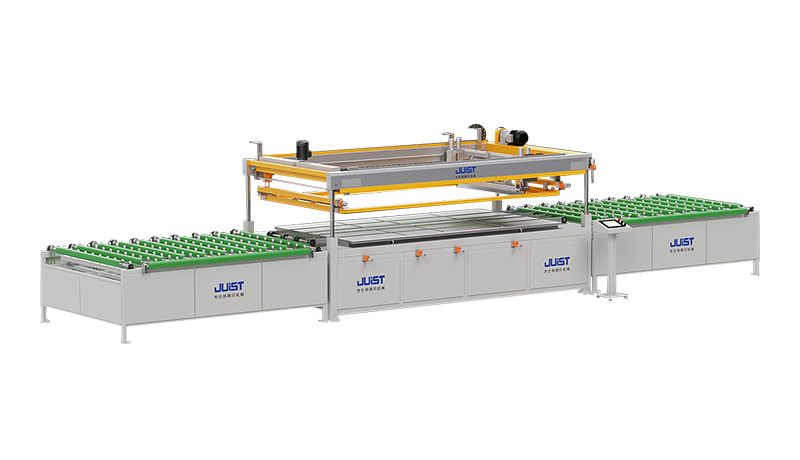+86-519-83387581
Have you ever lingered in the home appliance section of a mall, captivated by elegantly designed ovens, microwaves, or refrigerators? How do their sleek glass panels retain sharp brand logos, functional button icons, and even delicate decorative patterns with such precision and durability? This is no mere sticker or spray-paint job, but the result of a highly sophisticated manufacturing process—automated glass screen printing. As home appliances evolve toward smarter, more aesthetic designs, traditional production methods struggle to meet the stringent demands of the modern market. Manual screen printing, with its low efficiency and high error rates, fails to handle large-scale, high-standard production. Thus, fully automated glass screen printing equipment has emerged, revolutionizing the manufacturing of appliance glass panels and transforming the industry from labor-intensive to technology-driven.
“Precision” and “Efficiency”: Core Advantages of Automated Screen Printing Equipment
In home appliance manufacturing, especially for pattern printing on glass panels, precision is paramount. Whether it’s temperature scales on oven doors or function icons on microwave control panels, positioning must be exact and pattrns crystal-clear. Automated screen printing equipment integrates high-precision visual positioning systems and servo control, enabling it to capture glass panel positions with millimeter-level—or even finer—printing accuracy. This not only ensures flawless pattern presentation but also lays a solid foundation for subsequent assembly and functionality.
Efficiency is another core strength. Unlike manual operations, which require multiple workers and time-consuming efforts, automated equipment operates continuously, drastically shortening per-unit production cycles and exponentially boosting overall output. This not only cuts labor costs but also allows appliance manufacturers to quickly respond to surging market demand, seizing competitive opportunities.
Smart Appliances, Smart Manufacturing: The “Hi-Tech” Look of Control Panels
In today’s consumer market, home appliances are more than mere tools—they embody design aesthetics and smart experiences. The touchscreens and control panels of smart appliances serve as the interface for human-machine interaction, and their design directly impacts user perception and operational experience. Screen printing technology endows these glass panels with vibrant patterns and functional markings.
For example, multi-color screen printing can create layered decorative designs and functional buttons on a single glass panel, enhancing the product’s texture and tech appeal. For touch-enabled glass panels, screen printing must meet even higher standards: printing conductive inks and handling insulating layers with absolute precision to ensure touch sensitivity and stability. Automated screen printing equipment is irreplaceable here, precisely controlling ink thickness, print shape, and positioning to support both visual aesthetics and functional performance.
Beyond Printing: Full-Process Automation from Feeding to Curing
Modern automated glass screen printing lines encompass far more than just “printing.” They typically form a complete system integrating automatic loading/unloading, printing, drying, and material collection. When glass panels are precisely fed into the printing area via robotic arms or conveyors, high-precision screen printers spring into action. Post-printing, the panels automatically enter drying and curing ovens—a critical step that ensures ink adheres firmly to the glass, gaining properties like wear resistance, corrosion resistance, and heat resistance.
Drying and curing temperatures and durations are meticulously controlled to prevent glass deformation or ink degradation. Finally, finished glass panels are automatically collected, ready for the next production stage. This full-process automation drastically improves efficiency and product quality while reducing contamination and damage from manual handling, enabling cleaner, more efficient manufacturing.
How to Choose the Right Automated Screen Printing Equipment?
For home appliance manufacturers, selecting suitable automated screen printing equipment is key to boosting productivity.
-
Assess Equipment Performance Against Product Needs: Consider printing size, precision, speed, and multi-color capabilities. For example, manufacturers of large refrigerator doors need equipment with large-format printing capacity, while producers of high-end smart appliances should prioritize precision and color registration stability.
-
Evaluate Automation and Line Compatibility: Equipment that seamlessly integrates with existing production lines and features fully automatic loading/unloading delivers greater value.
-
Consider Customization Capabilities: As appliance designs diversify, equipment adaptable to special needs—such as irregular glass shapes or specialized inks—offers greater flexibility.
Choosing the right automated screen printing equipment is more than a machine purchase; it’s a long-term investment in future production efficiency, product quality, and market competitiveness.









